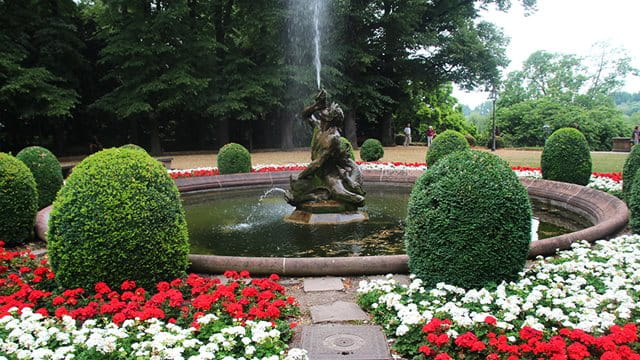Bolongaro Garden

A historical gem in garden design from the baroque period is located in Höchst, only a few steps away from the Main river. Behind the Bolongaro Palace, a terraced garden stretches out, decorated with balustrades and two rolling stairways all the way to the river. Of particular interest are the sandstone figures on the balustrade walls, which depict a Turkish chapel, as well the shell grotto with the so-called dragon fountain between both stairways. In the centre of the upper, larger part of the Bolongaro Garden is an oval fountain with an imposing statue of Neptune.
The construction of this baroque garden, which is the only one of its kind that still exists in Frankfurt, was initiated in 1775 by the Bolongaro family. In 1737, the Bolongaro brothers (snuff merchants and bankers) came from Stresa on Lake Maggiore to Höchst, which was then part of the Electorate of the State of Mainz. At the time the city of Frankfurt refused to grant them the rights of citizens. In 1768, the Elector Emmerich Josef von Breidbach-Bürresheim called for a complete baroque New Town to be planned next to Höchst’s Old Town. However, of this idealised baroque town, only the palace of the Bolongaro family was ever realised. In 1783, the family completed the magnificent palace, both garden pavilions and the representative garden.
After that a chequered history began for the palace and the garden: in 1813 Napoleon I took up residence here, and later Field Marshal Blücher. Höchst, which at the time was still an independent town, recreated the garden according to plans by Jakob Klomann in 1820. In 1906, the site was purchased by the town of Höchst and restored as a unique historical testimonial to early baroque town planning. The most obvious remodelling took place in the post-war years from 1947 to 1957, and the terraces were restored between 1985 and 1998.
Even today the overall impression created by the architecture and the garden has a special charm. Visitors particularly appreciate the beautiful view of the confluence of the Main and the Nidda. The building complex is now home to the agencies of the Höchst citizens’ office and the Höchst registry office.
Size: 0.4 hectares
